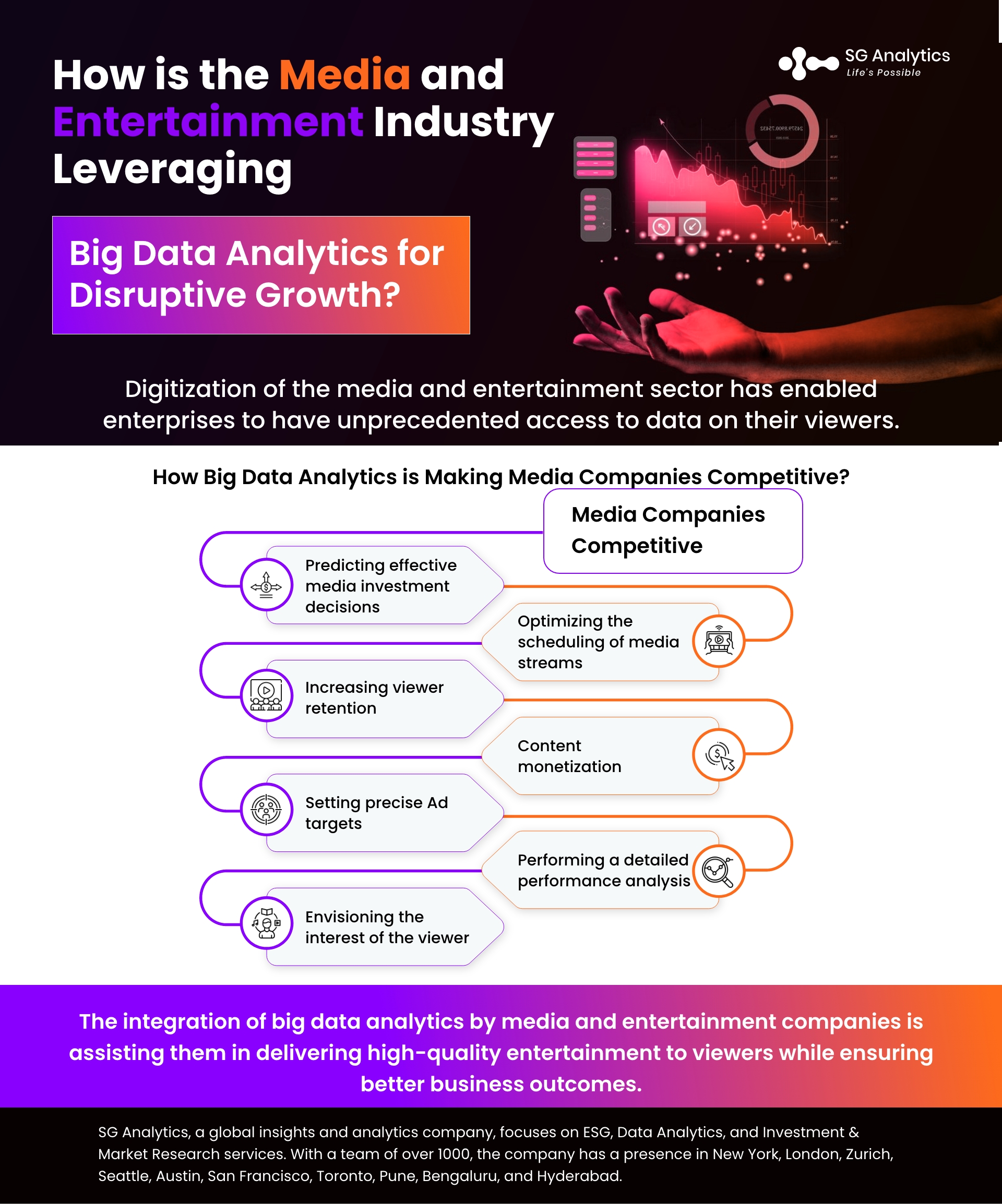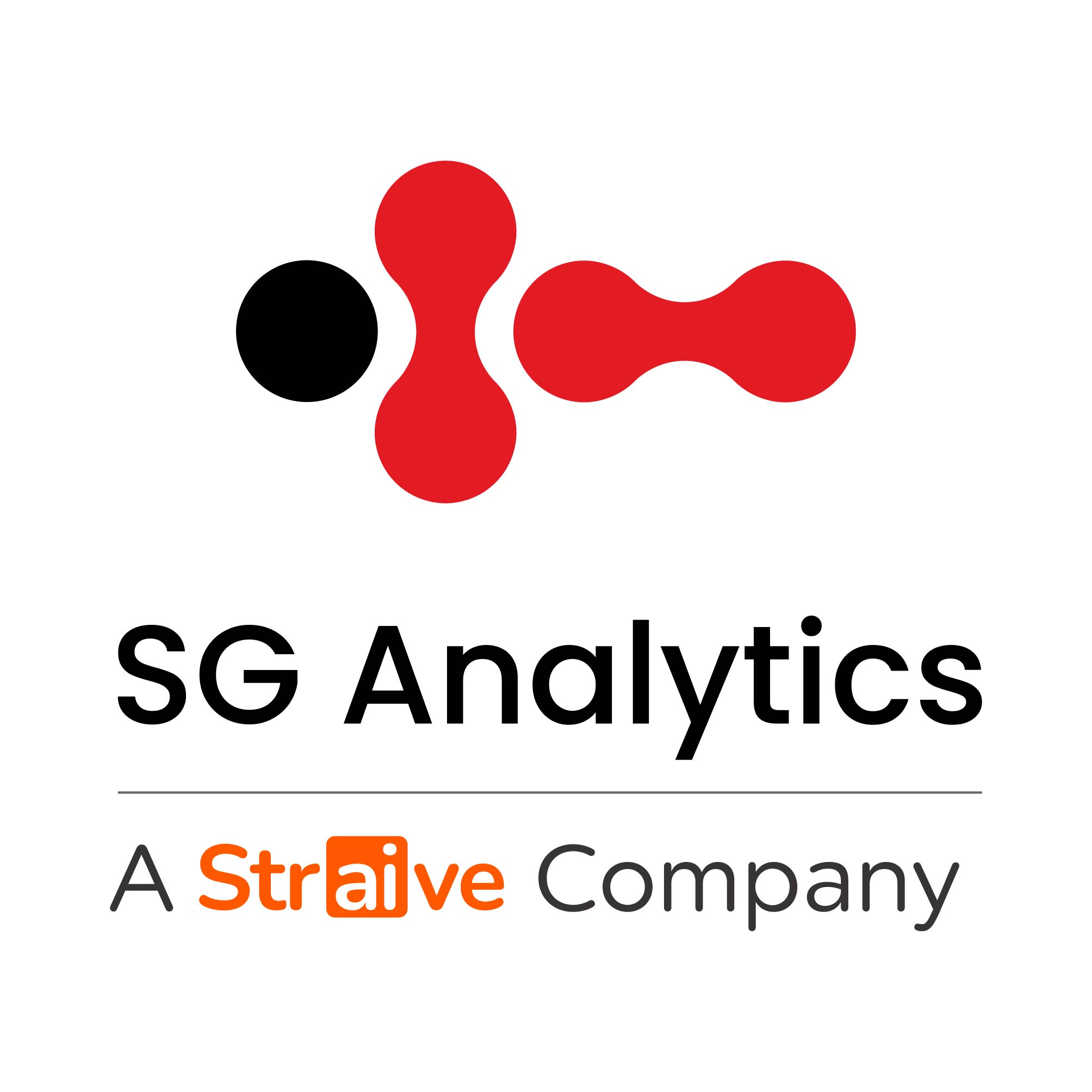In today's scenario, Media and Entertainment organizations are seeking to distinguish themselves from their competitors by presenting entertainment and content that their viewers prefer. To accomplish this, they must have an in-depth understanding of their viewers, including when and how the audience selects content and offerings. This is where big data analytics solutions play a vital role.
Pre-eminent partakers in the media and entertainment industry, including Netflix, Amazon, and Disney, have already been leveraging big data analytics as part of their operational framework to enhance the viewer's experience. Hulu is known for using analytics for content acquisition and recommendation. Similarly, many entertainment companies also incorporate big data and AI analytics to improve their offerings and streamline their processes. As a result, the media and entertainment sector is at a massive advantage.
Data Analytics in Media & Entertainment (M&E) Industry
Data analytics in the media and entertainment (M&E) industry is helping businesses gain hidden insights into viewers' behavior while assisting in delivering personalized content. Additionally, data analytics in the media industry is driving digital transformation as organizations are able to get their hands on precise data insights on viewers. Due to this reason, big data holds the key to driving profitability across the media and entertainment sectors.

How Big Data Analytics is Making Media Companies Competitive
Attracting new viewers and retaining the older ones while keeping them engaged are the biggest challenges faced by almost all media and entertainment companies globally. By integrating data analytics, entertainment corporations are able to gain detailed insights regarding their viewers as well as their systems and processes.
Read more: Emerging Trends in Media and Entertainment Industry
Media enterprises have been overcoming these challenges and achieving higher business outcomes. Some of the positive outcomes of data analytics are as follows:
-
Predicting Effective Media Investment Decisions
Media streaming platforms must ensure that the content they invest in will be well-received and successful among their viewers as well as deliver an adequate ROI. To assess the potential success of different media assets, media companies leverage data analytics to gain insights. By establishing the potential success of the content, digital platforms are able to generate huge dividends on their investments. Leading media company Warner Brothers invest in predictive analytics to predict the success of their movies. To refine the gathered insights delivered through analytics, media enterprises further automate reporting writing powered by natural language generation systems. As a result, they can convert insights into action and achieve better channel performance.

-
Increasing Viewer Retention
Media enterprises such as Viacom18 have been employing big data analytics to ensure viewer retention during break slots between program segments. This has enabled them to place the commercial breaks at the right time. As a result, Viacom18 has been able to retain its viewership during commercial breaks, thereby driving significant revenue for themselves as well as their advertisers. Following a similar path, other media enterprises have started using data analytics to drive similar initiatives to improve their customer engagement. By gaining an understanding of how well their content matches the demands of the viewers, M&E organizations can predict the different types of content recommendations to keep the users occupied on the site for extended periods.
Read more: How are Technological Advancements helping to Reshape Global Economic Growth?
-
Setting Precise Ad Targets
Advertising revenue is considered a major source of revenue generation for media streaming and entertainment corporations. To ensure that they display the most relevant ads to their users based on their different demography, media streaming enterprises use big data analytics for ad targeting and audience segmentation. Due to this, they are able to deliver greater ROI to their advertisers by helping them reach their target audience. By integrating big data analytics with machine learning, online streaming platforms, including YouTube, enhance the relevance of the displayed ads.

-
Performing a Detailed Performance Analysis
Network media and entertainment companies use analytics information in the form of language-based reports to study the performance of different channels and assets. With the help of this analytics data, media enterprises can gain real-time insights into the performance of their content as well as their competitors. This further assists in making enhanced strategies for growth.
-
Envisioning the Interest of the Viewer
The traditional method of media content development is being replaced by myriad media services like pay-per-view, live streaming, and much more. During this process of content delivery, media distributors are able to collect a vast amount of user data.
Media and entertainment companies are increasing their digital conversion rates by micro-segmenting their target audience across their advertising networks. Data analytics helps them in combining and making sense of all the collected user data from multiple sources, including social media.
But one of the critical challenges faced by the media and entertainment industry is the growing risk of customer churn. Big data in the media and entertainment industry is further helping in seeking an in-depth understanding of viewers' behavior and preferences. With the help of analytics solutions, media organizations can also uncover reasons that drive viewers to subscribe and unsubscribe to a particular channel or platform.

Read more: The World of Virtual Reality: How Virtual Entertainment is Integrating Cutting-Edge Technology?
-
Optimizing the Scheduling of Media Streams
A recent Statista report highlighted that nearly 2.62 billion people have social media accounts. This exponential growth of media distribution across digital platforms has reduced the barrier between distributors and end-users. With data analytics in media and entertainment service providers can reach their end-users directly without a conciliator. Furthermore, big data analytics is assisting media organizations in connecting and interacting with the audience directly through scheduled media streaming, thus maximizing their profits. Additionally, it has enabled the M&E industry to identify the exact content that customers wish to engage in on a scheduled basis.
-
Content Monetization
Media streaming platforms need to ensure that the content they invest in is well-received by the audiences and delivers an ample ROI. To assess the success across media assets and projects, media organizations are integrating big data analytics. Leading media conglomerate Netflix's investment in an American version of the British Show, House of Cards, proved successful, as they utilized insights captured from big data analytics and discovered the potential success of the show.

Leading media organizations are investing in predictive analytics technology to predict the success of the campaign and content. They are using technology to guide their decisions when investing in new strategies and ideas.
Read more: Top Customer Experience (CX) Trends You Don't Want to Miss
Adapting the Ongoing Changes in the Media & Entertainment Industry
Digitization of the media and entertainment sector has enabled enterprises to have unprecedented access to data on their viewers. Today's data is the new oil fueling powerful engines across industries to extract, refine, and harness operations efficiently. Organizations that build on a robust analytics foundation and a strong analytics culture are able to innovate and make wise decisions.
The ongoing changes in the media and entertainment business are likely to continue in 2023. Studios and video streamers are facing the reality of their own market disruption and exploring ways to gain profits in a less profitable business. Top social media services rely on user-generated video content (UGC), emphasizing the interests of viewers more than their connections. Today viewers are looking for more personalized content. The creator economy is supporting social media, and independent creators are getting closer to their audiences.

On the whole, the integration of big data analytics by media and entertainment companies is assisting them in delivering high-quality entertainment to viewers while ensuring better business outcomes.
With a presence in New York, San Francisco, Austin, Seattle, Toronto, London, Zurich, Pune, Bengaluru, and Hyderabad, SG Analytics, a pioneer in Research and Analytics, offers tailor-made services to enterprises worldwide.
A leader in the Media & Entertainment space, SG Analytics helps leverage advanced analytics capabilities to make accurate decisions and accelerate business growth. Contact us today if you are in search of media & entertainment solutions that enable businesses to solve problems by harnessing disruptive data, artificial intelligence, machine learning, and cutting-edge technologies.

